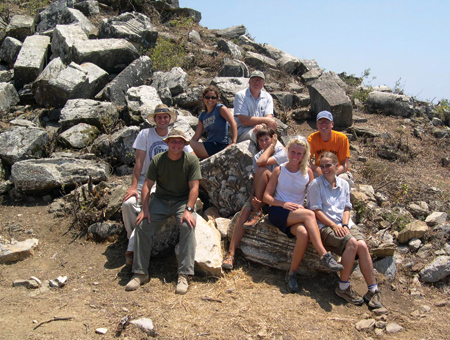To date approximately 410 blocks belonging to the temple have been catalogued and documented, representing approximately 50% of the architectural material of the collapsed structure. Of these approximately 220 complete or fragmentary blocks have been transported from the mound to an adjacent field where they have been placed on wooden skids. Each block is fully documented and photographed, and each side of the block has been drawn in order to help with the reconstruction. Blocks have been moved by means of a truck-mounted crane, capable of lifting up to ten tons. The methodology employed in the block removal has resulted in an efficient and expeditious process.
In 2008 team members employed a Ground Penetrating Radar unit to survey for underground features. The field adjacent to the temple, intended for storage of removed blocks, was surveyed first in order to confirm that it was free of any anomalies that might warrant investigation. The GPR unit was then employed in surveying the top of the temple platform once all architectural blocks had been removed from this area. GPR scans indicated the presence of an intact arched vault underneath the stone platform. The presence of a stone vault within the podium had already been suspected, since other temples in western Rough Cilicia, such as at nearby Selinus and Nephelion, contain this feature. Almost nothing is known about the purpose of such vaults, however. For example, the vault within the Selinus temple, which is thought to have been dedicated to Trajan, has been exposed at least since the 12th century, when the structure was modified by the Seljuks; nothing remains but bare raised banks along the walls of the vaulted chamber where votive objects may have been placed.
In addition, Professor Erdo?mu?, the architectural engineer, has begun an analysis of the blocks and the lime mortar found at the site, in order to 1) gather the authentic material properties (i.e. mechanical and chemical characteristics), 2) assess the condition and the capacity of the existing materials for repair and strengthening plans. For this purpose, laboratory analyses and site assessments were carried out by Erdo?mu? and her student assistants.
In 2008 team members employed a Ground Penetrating Radar unit to survey for underground features. The field adjacent to the temple, intended for storage of removed blocks, was surveyed first in order to confirm that it was free of any anomalies that might warrant investigation. The GPR unit was then employed in surveying the top of the temple platform once all architectural blocks had been removed from this area. GPR scans indicated the presence of an intact arched vault underneath the stone platform. The presence of a stone vault within the podium had already been suspected, since other temples in western Rough Cilicia, such as at nearby Selinus and Nephelion, contain this feature. Almost nothing is known about the purpose of such vaults, however. For example, the vault within the Selinus temple, which is thought to have been dedicated to Trajan, has been exposed at least since the 12th century, when the structure was modified by the Seljuks; nothing remains but bare raised banks along the walls of the vaulted chamber where votive objects may have been placed.
In addition, Professor Erdo?mu?, the architectural engineer, has begun an analysis of the blocks and the lime mortar found at the site, in order to 1) gather the authentic material properties (i.e. mechanical and chemical characteristics), 2) assess the condition and the capacity of the existing materials for repair and strengthening plans. For this purpose, laboratory analyses and site assessments were carried out by Erdo?mu? and her student assistants.
